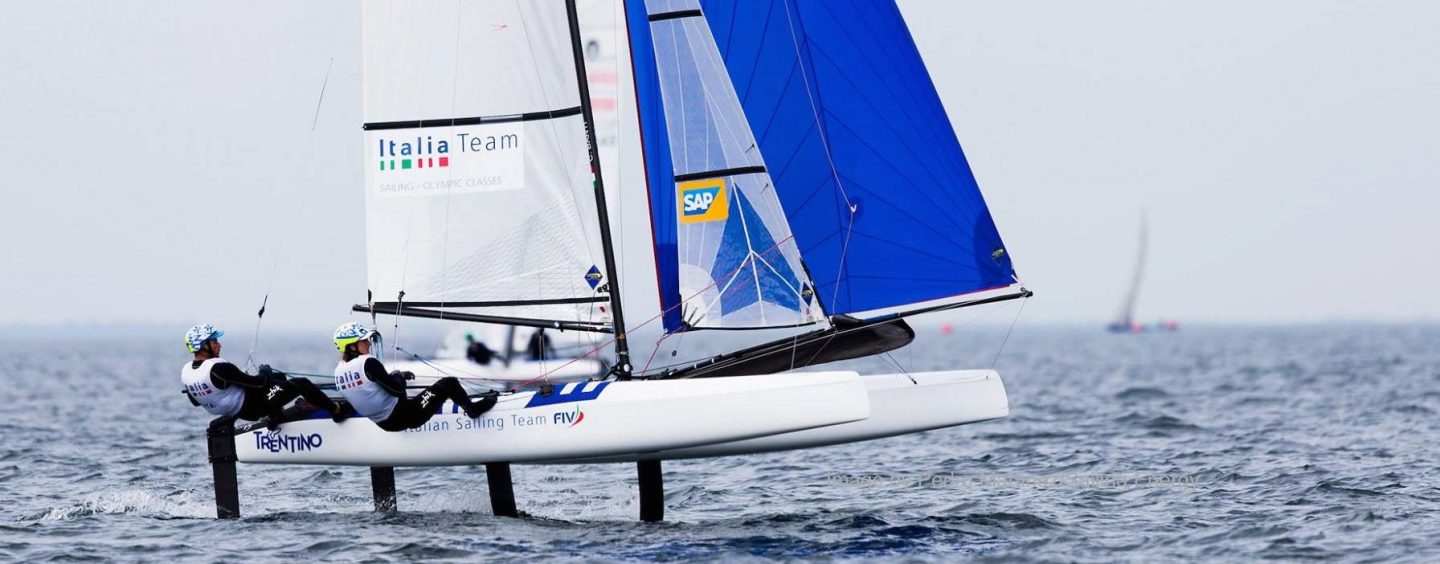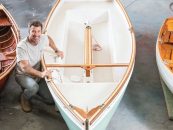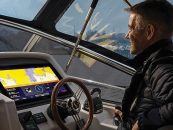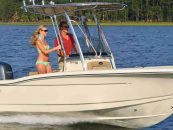Southeast Queensland is home to a passionate NACRA catamaran racing community. What began as an American racing phenomenon really caught on in Australia in the 1980s, and is thriving today thanks to the help of many locals. Aussie international champions, like Nathan and Haylee Outteridge, are inspiring new sailors, whom the yacht clubs are training up to be future champions. And the local NACRA manufacturing in Brisbane is helping to innovate the sport with new models of the popular cats.
NACRA stands for North American Catamaran Racing Association, which began in 1975, focusing on the racing side of beach cats. The small cat industry was in the midst of a huge boom at the time, thanks in large part to the American Hobie Cats, which had popularised the small fibreglass boats that could easily be launched and sailed from the beach by one or two people.
During the 1980s, beach cats were huge, especially in Australia, as every major tourist beach had some for hire. For many, spending hours coasting along the shoreline on these little cats was an iconic holiday tradition.
Sailboat designer, Tom Roland, saw the racing potential of these beach cats and founded NACRA, the first company to design high-tech racing cats. Unlike the Hobie cats, which are bee-shaped and ride lower in the water, the NACRAs have much wider bottoms, allowing them to ride higher and travel much faster.
The company has had numerous location and name changes over the decades. In the 1980s it was based in California and operated as Performance Catamarans. For the last decade, NACRA has been owned and managed from the Netherlands.
In recent years, NACRA cats have become increasingly prominent in the international racing scene. The NACRA 17 was designed specifically for Olympic selection, which it successfully won in 2012 to become the official boat of the Mixed Multihull class at the Rio 2016 games. Excitingly, the curved daggerboards that enable foiling will be added to the NACRA 17 for the Tokyo 2020 Olympics.
The local NACRA Australasia business is based in Brisbane, and is run by passionate cat sailors Warren and Ross Guinea. They have been manufacturing NACRAs locally since 1985. At that time, the original beach cat boom was ending because the Aussie economy was in a recession, and new sports like windsurfing were taking off. To thrive in this difficult market, the Aussie team innovated and designed many new NACRA cats specifically designed for Australians. Many of these new models have been so successful they have been added to the NACRA worldwide range.
One of the most successful locally designed cats is the NACRA 350. At just 3.5 metres in length, it was designed to be small enough that it could be sailed by one or two children, while still being fast and agile enough to excite them about the thrills of cat racing. The boom-less sail ensures it is very safe for kids and it is easy to right after capsizing too. The hulls have also been designed with additional bulkheads to make sure they withstand the punishment kids dish out. At just 2.1 metres wide, they can easily be transported on regular trailers. The 350’s lightweight build also makes it an attractive option for elderly sailors wanting a cat that is not too physically demanding.
Although many Australians prefer the smaller NACRAs like the 350, Warren and Ross produce 10 different models and sell 30-50 new cats each year. The NACRA 4.5 is a metre longer than the 350 but is still capable of being sailed solo. At just under 6 metres, the NACRA 5.8 is a very popular mid-range cat, requiring a crew of at least two people. And, of course, there is the professional Olympic model, the NACRA 17, which is built for speed and foiling.
It is a testament to the build quality of the NACRAs that Warren said the fundamental build process has remained the same over the last three decades. The process, however, is very labour intensive, with each boat normally requiring Warren and Ross to spend eight days moulding and finishing the cat.
“Each year, we hold the racing nationals in different states on a national rotation, this year we are in Forster, NSW. It began with the one model, the NACRA 5.2, and we only had 30 boats. But this year for the 40th Anniversary in December we’re expecting 70-plus cats. And thanks to the introduction of the NACRA 350 a few years back, we are now getting 20 kids racing at the nationals,” Warren explained proudly.
One of the key people training these young sailors is Kerry Noyes, Southport Yacht Club’s Commodore. Kerry is an avid NACRA racer personally, and is very dedicated to helping train tomorrow’s champions.
Kerry’s husband, Steve Curtis, has always been a cat sailor, and he convinced her to give it a go when she was 50. Kerry took to the sport like a fish to water, and soon after, won the 2006 nationals with a NACRA 5.0. In recent years, she has been a regular competitor in the nationals, racing some years with her husband, and other times with NACRA Australasia’s Warren Guinea.
The Southport Yacht Club runs many events to encourage new Aussies to enter the sport. “On our try-sailing days, we normally get 800 people through the gates, and the cats are always the most popular,” Kerry said. “We also offer all levels of sailing courses, for eight-year-olds and up, as well as scholarships. The more experienced sailors are always happy to share their knowledge and get you started. It is a very inclusive community. Putting your name down on crew lists is a good option if you cannot afford to buy your own boat, because skippers are always looking for crew.”
There is currently a fleet of 15 NACRA cats at the yacht club. Kerry believes the popularity of the boats is due to their affordability and versatility. “NACRA racing is for everyone, not just for elites. People also like that skill is more important than your wallet. A skilled sailor on a clunker will always beat a new boat that is not being sailed well. The sport caters to all ages, and a big range of fitness levels too. You could be in your 70s and enjoy a relaxed sail or you could be a serious athlete, on the road to the Olympics, who is straining core muscles to lean right out while the cat is foiling at 25 knots.”
Australian athletes are among the most competitive in the international NACRA events. Aussie sailors Jason Waterhouse and Lisa Darmanin won the silver medal in the NACRA 17 class at the Rio 2016 Olympics. The Aussie NACRA sailing team have also benefited from the recent additions of Haylee and Nathan Outteridge. The Outteridge siblings are best known for their 49er sailing, with Nathan being the London 2012 Olympic gold medallist.
Although the Outteridges are new to NACRA, their years of experience, especially with foiling, have allowed them to hit the water running. The pair have already distinguished themselves in Denmark, winning silver in the World Sailing Championships NACRA event.
Nathan offered some insight into how he and Haylee managed to do so well in Denmark. “Our previous Olympic sailing experience in 49ers has helped with the steep learning curve over the last few months. Obviously, one of the big strengths we bring is foiling experience. I have sailed nearly every foiling boat that exists, so I have been able to use this to fast-track our NACRA 17 sailing. The Australian Sailing Team’s NACRA program has been hugely beneficial too. Having Jason and Lisa as training partners has been invaluable.”
The announcement that the NACRA cats will be foiling in the 2020 Tokyo Olympics has Nathan excited. However, there is still room to improve the technology. “Unfortunately, the boat does not foil upwind in most conditions and it really struggles to foil when there are decent waves. There has been a lot of development in foiling technology in recent years, and I really hope that the class can upgrade the boats to make the racing safer and more exciting.”
Like Warren and Kerry, Nathan believes yacht clubs are the perfect way to discover the benefits of NACRA. “Anyone interested in the sport should get involved through their local yacht club. They are always looking for new members. Their sailing programs are great fun and a place to meet people who share the passion for being on the water and sailing. I started at a young age at our local sailing club and have made life-long friends.”
By Narayan Pattison






























